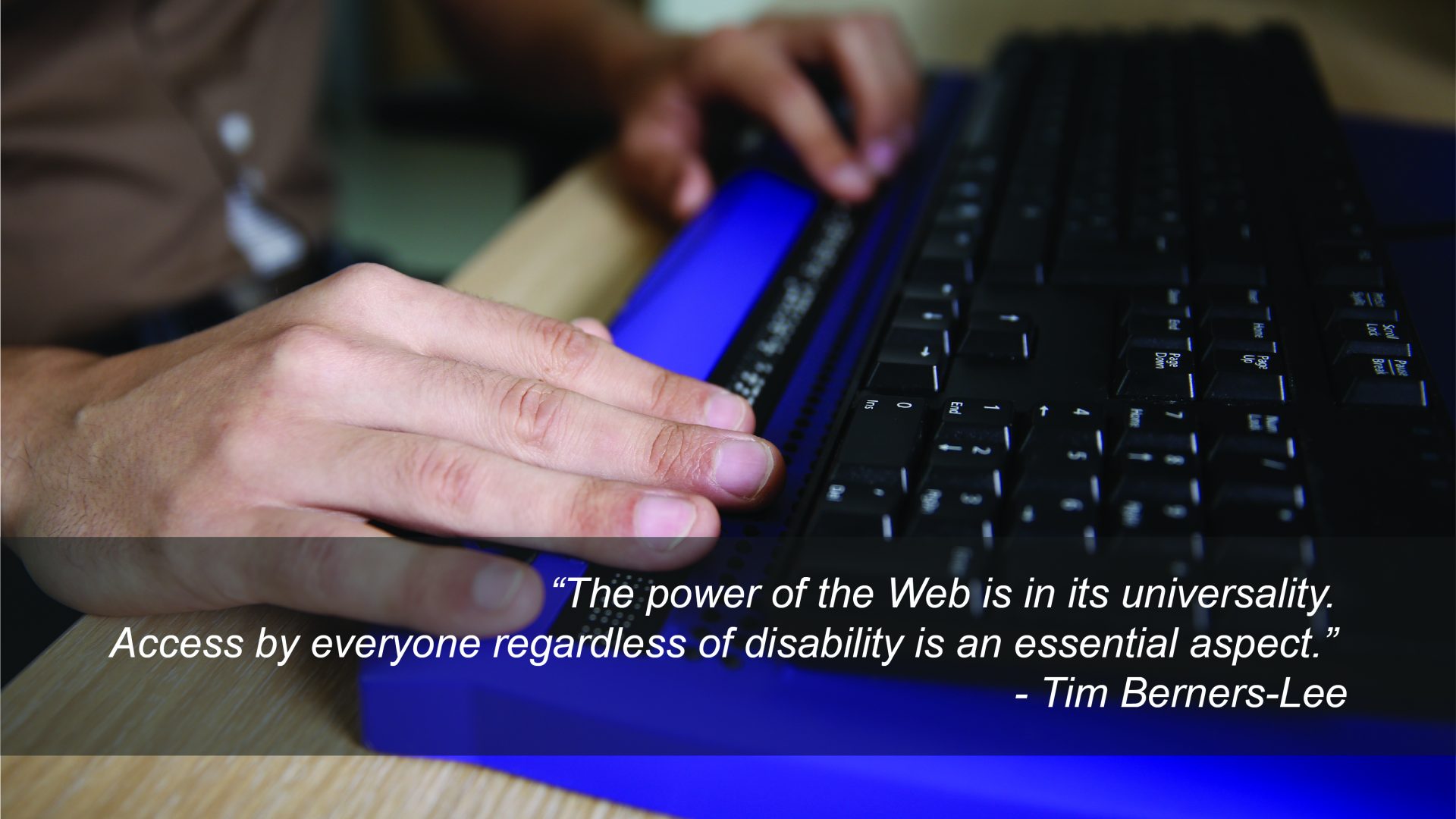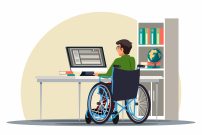Digital accessibility is not renowned for being inclusive or easy to grasp. The Web Content Accessibility Guidelines (WCAG) assume a knowledge of coding which is beyond that of many professionals. They also assume an awareness of the needs of disabled users and their assistive technologies. Accessibility can seem like a mountain to climb – and for what purpose? How much extra time will you have to invest? Who will pay for it? How many actual users will benefit?
These are natural questions to ask and are worth addressing. But they are not the right questions to start with. Digital accessibility is less about standards and more about mindsets, opportunity and professional ‘value added’.
Digital Vs Non-Digital Resources:

With non-digital resources – like a printed handbook – the difference in user experience and accessibility between and amateur version and a professional version is minimal. The professional one might have glossy paper and neater typesetting but from the user’s experience they both contain words and pictures. Neither is more ‘accessible’ than the other because neither can be personalized to suit user needs. On a hard copy document, font size, type, spacing, and color are set. Neither the professional nor the amateur version will read its content to you. What you see is exactly what you get.
Digital resources are different. An amateur can create a PDF document which may be capable of some personalization. For example, it may reflow when magnified just because the authoring tool they have used has a responsive template. But a professional with accessibility expertise would bring enormous added value. Their version of the resources may be fully capable of test-to-speech, adaptable in terms of fonts, colors and contrasts, and equally navigable by mouse and keyboard. It may entirely operable by the visual impaired who access the content using a blink operated switch. Digital accessibility is an exercise in opportunity and imagination. It will not only make your agency accessibility friendly, your repertoire wider, and your problem solving more agile.
So, where do you begin?
Assistive Technology Users

The best way to find out more about assistive technology is to see it being used by people who have experience some form of disability. This not only gives a better understanding of the challenges which they face as a result of inaccessible content, it allows you to appreciate the different skills and expertise that users develop. According to WebAIM, “experience users often like to speed up the reading rate to 300 words per minute or more”. This is much faster than most listeners can understands. It is a powerful example of the capacity that people have to develop existing skills and learn new ones in order to adapt to their environment and circumstances.
Assistive Technology for Visual Impairments
Assistive technology for leaners with visual impairments include screen readers, refreshable braille displays, and screen magnifiers.
Screen Readers:
Screen readers convert what is on a computer screen into information that can be output through synthetic speech or braille. Some screen readers also play sound cues when certain actions are performed, such as activating a link or menu item. In addition to outputting information, screen readers enable users to navigate content. They use keyboard commands or shortcuts to allow users to move between items such as headings, images, paragraphs, and lists. They also have commands which allow users to move to tables and navigate the rows and columns inside them so that the data they hold can be successfully interpreted.
Common specialized screen reader keyboard commands include ‘L’ to jump to the next list, ‘K’ to jump to the next link and ‘G’ to jump to the next graphic. Screen reader users also use the same standards keyboard commands as people who navigate using the keyboard. These include ‘Tab’ to jump to interactive items, ‘Enter’ to activate links and “Enter’ or ‘Space Bar’ to activate buttons.
Making Content Accessible for Screen Reader Users
Many of the requirements needed to make content accessible for screen reader users are achieved using the underlying code of the tool. This applies to the ability to identify and interpret structures such as tables, lists, and page regions. This is done using appropriate HTML elements, for example <h1> for level one headings, <li> for lists, <img> for images.

Note: Good screen reader user experience, however, does not rely solely on underlying code. Content creators are responsible for adding alternative text, ordering items correctly, and avoiding programming single characters key shortcuts which can interfere with commands.
Refreshable Braille Displays
Refreshable braille displays are used by people who are blind or have low vision. They are electronic devices which create six to eight do braille characters using moving pins. These are lowered and raised to forms braille in cells which are arranged in a linear order. The number of cells typically range from 12 to 88. Braille displays have traditionally needed a screen reader in order to work. As a result of recent advances in technology, however, this is no longer always the case. Some displays, for example, can work with Windows Narrator.
Making Content Accessible for Braille Display Users
An important consideration to be aware of is that it many take braille users longer to process content. This could be due to the time it takes to convert text into braille and the number of cells that are available on the device being used. This makes it important that any time limits imposed are adjustable, or better still that they are avoided. It also makes clear and concise text extremely helpful. Providing descriptive transcripts for audio and video content is also vital for deafblind users who use refreshable braille displays and who may now be able to see or hear the content.
Screen Magnifiers
Screen magnifiers enlarge the size of text and images on the screen for better visibility. They can be used to magnify small areas of the screen around the mouse cursor or to enlarge the while page and zoon in on a particular area. They can be operated by using either the mouse or keyboard commands to enlarge portions of the screen and can also be programmed so that the cursor moves automatically depending on a pre-set speed.

Screen magnifiers sometimes have additional functionality, such as allowing users to invert colors, using shading to help people find their place on a large page, and customizing the cursor to make it more visible. Many of the leading screen magnifiers also come combined with screen reader functionality.
Assistive Technology for Motor Impairments
In a digital context, motor impairments include and conditions which limit people’s ability to interact with computer hardware or mobile devices. For example, people with motor impairments which affect manual dexterity may find it difficult or impossible to use a standard mouse or a desktop, a trackpad on a laptop, or finger gestures on a mobile device. There is, however, a wide variety of assistive devices and software which give people alternative ways to interact with digital content.
Keyboards
Although keyboard is a standard way to input data, it can also be considered a form of assistive technology. This is the case where someone predominantly uses a keyboard to navigate and input data.
Adaptive Keyboards

Keyboards can be adapted in various ways to help people with motor impairments. This can be something as simple as the shape, as is the case with ergonomic keyboards. These are designed to minimize muscle strain, normally by allowing users to type with hands at a slight angle. Other adaptive keyboards have accommodations such as raised areas in between keys which let people places their hands on the keyboards and then run their fingers along the raised areas to the correct key. They can also have separate numeric pads, larger keys or high-contrast keys as with high-visibility key boards. Adaptive keyboards include specialized keyboards such as braille or chording keyboards. Onscreen keyboards are another form of adaptive keyboard or keyboard interface.
Switches
A wide variety of devices come under the umbrella term switches. These can vary from mechanical buttons which are placed according to the range of movement available to the user, for example next to the head or on the arm of a mobility device such as a wheelchair, to sip and puff switches activated by inhaling or exhaling, and cheek sensor switches activated by movement. Switches can also be activated by bite, footplates or handle bar-like grasps. The actions of switches are interpreted by specialist software on the computer, allowing the user to both input data and navigate content.

Voice Recognition
Voice or speech recognition software allows users to use a microphone and voice commands to input test and to perform mouse action such as opening a file or printing. Many of us may already be familiar with similar technology in the form of voice assistants such as Apple’s Siir, Microsoft’s Cortana, and Google Assistant. The software used in assistive technology is more sophisticated and has the capability of being trained to recognize a user’s voice. This is particularly important for conditions which might make speech less clear and also those that can sometimes lead to changes in a voice during the course of a day.
Final Thoughts
The range of assistive technology available for people with disability are numerous. Much of assistive technology which makes digital content more accessible to people helps with reading, writing, and concentration issues. Additionally, there are a number of third-party software that assist with documents remediation at large scale. This is especially true for government agencies that have to comply with accessibility standards and are in a hurry to meet deadlines.
accessibilityInsight™ is a complete platform for the creation and management of accessible documents. Providing high levels of automation and integration into any environment, the platform includes software solutions and a wide range of tailored services to meet accessibility guidelines for private organizations and government departments and agencies of all levels and sizes. Leveraging AI and automation, the comprehensive accessibilityInsight™ platform is flexible and supports both the unique processing requirements of high-volume transactional documents as well as static documents of all types.


